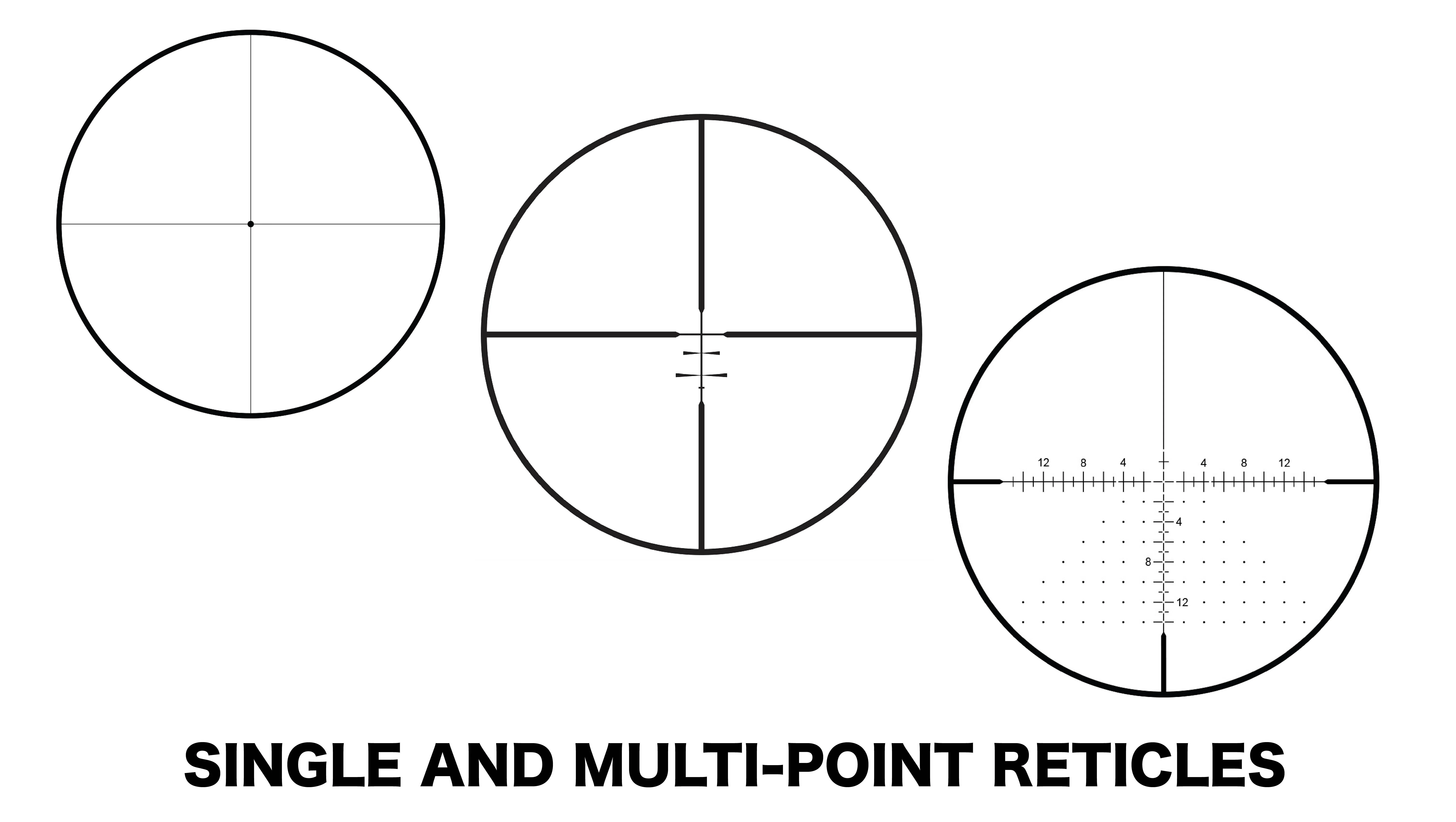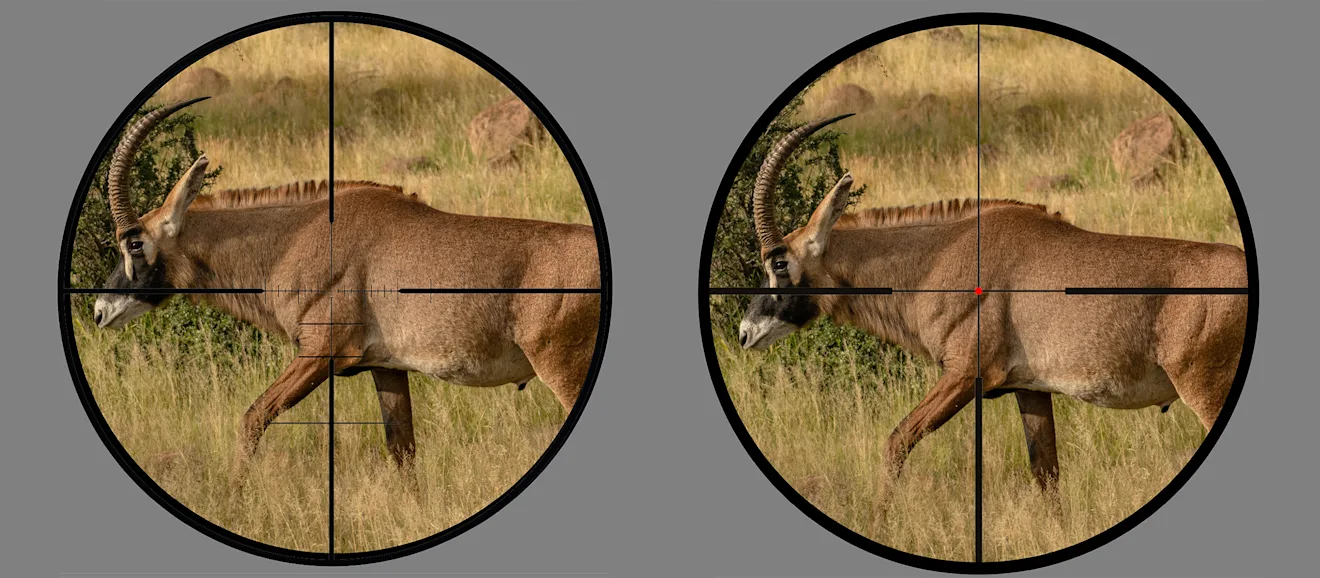Every modern hunter knows that a riflescope is a critical shooting accessory, but the reticle inside the riflescope is just as important because it is what you aim with. Riflescope reticles have evolved over the years—and especially recently with the long-range trend—and there’s now a wide selection for you to choose from. The only downside to this is that choosing the best one can get confusing quickly.
That's why it's best to start out simple. At the most basic level, there’s really only two types of riflescope reticles: single-aiming-point and multi-aiming-point reticles. Once you've made that decision, then it's time to break down the variables within that category. So, let's do exactly that. Here’s a look at the most common riflescopes reticles and what you need to consider to pick the right one for your purposes.
Single-Point vs Multi-Point Reticles

For many years, hunters used reticles with only a single aiming point, like the plain crosshair or post reticle. As rifle cartridges became more powerful and shooters became savvier, manufacturers created reticles with additional aiming points strategically positioned on the lower vertical crosswire. These became known as bullet drop compensating (BDC) reticles because the additional aiming points coincided with various bullet trajectories, generally at 100 yard increments.
With the big trend toward long-range shooting, more and more hunting-scope manufacturers now offer multi-aiming-point reticles with reference marks positioned in MOA or MIL increments. The aiming points on these ballistic reticles do not correlate to actual trajectories, but you can use them for range estimation and trajectory reference. No matter how many aiming points a reticle has, manufacturers must place the reticle in either a first or second focal plane. So let's look at that next.
First and Second Focal Plane Reticles

A reticle in the first focal plane (FFP) changes size when you adjust magnification, so that the relationship between the reticle and the target is constant. The big upside to this—and the reason FFP scopes are often preferred for long-range work—is that the additional aiming points of a graduated or BDC-type reticle work at any magnification. One downside to FFP scopes, particularly one with a broad magnification range, is that at low magnification the reticle can appear very thin—so thin that in some cases it can be hard to in low light or over a cluttered background.
A reticle in the second focal plane (SFP) does not change size when you adjust magnification. When you zoom in, only the target appears bigger, but not the reticle. The relationship between the reticle and the target is not constant with an SFP scope, and as a result, the additional aiming points on a graduated of BDC-type reticle typically work only at maximum magnification. That said, SFP reticles are generally easier to see in all conditions.
Related: FFP vs SFP Riflescopes: Which Is Right for You?
Illuminated Reticles

Some reticles also have illumination provided by battery, solar, Tritium, or some combination of the three. Illuminated reticles are great for low-light shooting and most have a brightness adjustment. With some, you might find that the exact or desired brightness setting does not exist or match your situation, but most of the time, illuminated reticles are a good choice, and you can always turn it off if you don’t want to use it. Illumination is especially nice with FFP reticles because it makes them easier to see at low magnification.
What Reticle is Best for Hunting?
The answer, of course, is: It depends. Ideally, you want to match your reticle to your specific needs based on what, where, and how you're hunting. This makes reticle selection critical and is why most riflescope manufactures offer a variety. Swarovski has seven different reticles and Leupold offers more than 40. One good way to simplify things, however, is to focus primarily on the distance you expect to be shooting. Here's a breakdown.
Best Reticles for Short Range

I define short-range as shooting at distances inside 250 yards or so. With the most common hunting rifle cartridges, you can use a maximum point-blank zero and hold dead on out to around 250 yards or a bit farther. If you do that, your bullet will never be more than 3 inches below or above your point of aim. You could also consider short range as any distance where you do not have to hold above the animal to account for trajectory. When shooting inside these distances, it takes a 10mph or stronger wind at a 90° angle to substantially move your bullet, so wind correction is not usually needed.
In short-range situations, a single-aiming-point SFP reticle like a duplex or post reticle works great and makes aiming very simple. Just hold dead on out to your maximum point-blank range, and if the animal is a tad farther away, hold just a little bit high or get closer. This is also the way to go with woods rifles, like a 30-30 or 45-70 lever gun where shot distances will rarely exceed 150 yards.
The Best Reticles for Moderate Range

Short, moderate, and long range is relative to the rifle cartridge you’re using, but with high-velocity cartridges like the 243 Winchester, 6.5 Creedmoor, or 30-06, moderate range would be somewhere between 250 and 500 yards. At distances beyond 250 yards or so, you’ll need to correct for trajectory, and a BDC reticle can make this easy. It won’t provide the exact correction at every distance, but if you adjust your zero so the reticle is dead on at the furthest distance you intend to shoot, they work very well.
With higher-power scopes, an FFP reticle is generally best here because you don’t have to worry about adjusting the magnification before you use the BDC reticle. With lower-powered riflescopes, you’ll most likely adjust to maximum magnification before you shoot at longer distances anyway, and the always-easy-to-see SFP reticle will work just fine.
The Best Reticles for Long Range

I consider long range any distance beyond 500 yards, but it could be closer with slow-velocity cartridges. I also consider shooting at a big-game animal at long range sort of foolish, especially when the bullet’s time of flight exceeds a third to a half of a second. Those with the skill to make long-distance shots routine (and those people are damned few) are best served dialing in a shooting solution because BDC reticles are not very reliable beyond 450 to 500 yards. Also, past those distances, you must always account for the ever changing environmental conditions.
Because you’re dialing in a correction, a FFP reticle with a lot of aiming points is not necessary. However, a reticle with reference marks for wind drift correction can be useful. Just remember, if these reference points are on a SFP reticle, they’ll only provide the correction you want when the riflescope is at maximum magnification.
Related: Bullet Time of Flight—And Why It Matters
Keep it Simple
Recently, multi-point MOA and MIL reticles have become very popular for hunting, partly because of their success in long-range competitions, but also because hunters like to pretend that they’re all well-trained snipers. These reticles look complicated because they are, especially for your average hunter who shoots less than a box or two of ammunition through their rifle each year. They are great for impressing your hunting buddies around the campfire, but not so practical in the field.

For most big-game hunting, the simple duplex-style reticle still works wonderfully well, whether you use Kentucky windage or dial in your shooting solution. If you like the idea of a BDC reticle, the subtensions of the additional aiming points are important and most manufactures offer schematics of those dimensions, or like Swarovski, they have an on-line application explaining them. The modern, high-tech reticles designed for long range require intense initial and frequent sustained training for successful application. If you have the time and patience to do that, great. But be realistic. If you don't, or might not, forget it. Hunting is hard enough, so why overcomplicate the shooting part? An easy-to-see and simple-to-use SFP reticle is rarely the wrong answer. If you'll do most of your hunting at moderate ranges, a not-too-complicated FFP is also a good option. Add a little illumination to either, and you should be good to go for most any hunting situation.


